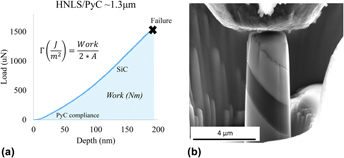Crossref Citations
This article has been cited by the following publications. This list is generated based on data provided by
Crossref.
Corujeira Gallo, Santiago
Li, Xiaoying
Zhang, Zhenxue
Charitidis, Constantinos
and
Dong, Hanshan
2018.
Viscoelastic response of carbon fibre reinforced polymer during push-out tests.
Composites Part A: Applied Science and Manufacturing,
Vol. 112,
Issue. ,
p.
178.
Zhang, Yanhui
and
Sanvito, Stefano
2019.
Interface engineering of graphene nanosheet reinforced
ZrB2
composites by tuning surface contacts.
Physical Review Materials,
Vol. 3,
Issue. 7,
Yang, Haitang
Xu, Shenwei
Yang, Pingping
Chen, Yang
Dong, Leiting
Guo, Zaoyang
and
Huang, Xiaozhong
2019.
Mechanical properties of SiCf/SiC mini-composites reinforcements for SiCf/SiC composites.
Journal of Physics: Conference Series,
Vol. 1347,
Issue. 1,
p.
012047.
Diaz, Oriol Gavalda
Marquardt, Katharina
Harris, Stephen
Gale, Louise
Vandeperre, Luc
Saiz, Eduardo
and
Giuliani, Finn
2020.
Degradation mechanisms of SiC/BN/SiC after low temperature humidity exposure.
Journal of the European Ceramic Society,
Vol. 40,
Issue. 12,
p.
3863.
Wang, Jun
Feng, Yajie
Zhao, Gang
Yang, Lingwei
and
Xu, Jian
2020.
Effect of elastic and thermal mismatch on push-in mechanism and shear strength measurement of fiber/matrix interface.
Composite Interfaces,
Vol. 27,
Issue. 10,
p.
921.
Li, Guangda
Zhang, Kaili
Pei, Zhengjun
Liu, Pinjue
Chang, Jiamian
Zhang, Kexing
Zhao, Santuan
Zhang, Kunpeng
Jiang, Ningning
and
Liang, Gaofeng
2020.
Basalt fibre reinforced calcium phosphate cement with enhanced toughness.
Materials Technology,
Vol. 35,
Issue. 3,
p.
152.
Hussey, A.
De Meyere, R.
Deck, C.
Armstrong, D.E.J.
and
Zayachuk, Y.
2020.
Statistically sound application of fiber push-out method for the study of locally non-uniform interfacial properties of SiC-SiC fiber composites.
Journal of the European Ceramic Society,
Vol. 40,
Issue. 4,
p.
1052.
Salmany Kozekanan, Behnam
Moradkhani, Alireza
Baharvandi, Hamidreza
and
Ehsani, Naser
2021.
Mechanical properties of SiC‐C‐B4C composites with different carbon additives produced by pressureless sintering.
International Journal of Applied Ceramic Technology,
Vol. 18,
Issue. 3,
p.
957.
De Meyere, Robin M. G.
Gale, Louise
Harris, Stephen
Edmonds, Ian M.
Marrow, Thomas J.
and
Armstrong, David E. J.
2021.
Optimizing the fiber push‐out method to evaluate interfacial failure in SiC/BN/SiC ceramic matrix composites.
Journal of the American Ceramic Society,
Vol. 104,
Issue. 6,
p.
2741.
Xiao, Peng
Wang, Song
Yu, Yiping
Fang, Bing
and
Li, Hao
2021.
Improved toughness of HfC with tantalum fibre net and tantalum foil.
Ceramics International,
Vol. 47,
Issue. 13,
p.
19260.
Cygan, Tomasz
Wozniak, Jaroslaw
Petrus, Mateusz
Lachowski, Artur
Pawlak, Wojciech
Adamczyk-Cieślak, Bogusława
Jastrzębska, Agnieszka
Rozmysłowska-Wojciechowska, Anita
Wojciechowski, Tomasz
Ziemkowska, Wanda
and
Olszyna, Andrzej
2021.
Microstructure and Mechanical Properties of Alumina Composites with Addition of Structurally Modified 2D Ti3C2 (MXene) Phase.
Materials,
Vol. 14,
Issue. 4,
p.
829.
Kabel, Joey
Edwards, Thomas E.J.
Hain, Caroline
Kochetkova, Tatiana
Parkison, Darren
Michler, Johann
and
Hosemann, Peter
2021.
A novel fiber-fretting test for tribological characterization of the fiber/matrix interface.
Composites Part B: Engineering,
Vol. 206,
Issue. ,
p.
108535.
Chen, Ruoyu
Jin, Xinxin
Hei, Daqian
Lin, Peng
Liu, Feng
Zhan, Jie
Lao, Dong
Li, Minghui
Jia, Wenbao
Shan, Qing
and
Li, Saisai
2021.
Enhanced mechanical strength of SiC reticulated porous ceramics via addition of in-situ chopped carbon fibers.
Journal of Alloys and Compounds,
Vol. 888,
Issue. ,
p.
161638.
Vo, H.T.
Still, E.K.
Kabel, J.
Auguste, R.
Schreiber, D.K.
Chou, P.H.
and
Hosemann, P.
2021.
Development of microscale bicrystal tensile testing for strength measurement of oxidized grain boundaries of alloy 600 exposed to PWR environments.
Materials Science and Engineering: A,
Vol. 815,
Issue. ,
p.
141197.
De Meyere, Robin M. G.
Song, Kay
Gale, Louise
Harris, Stephen
Edmonds, Ian M.
Marrow, Thomas J.
Saiz, Eduardo
Giuliani, Finn
Armstrong, David E. J.
and
Gavaldà-Diaz, Oriol
2021.
A novel trench fibre push-out method to evaluate interfacial failure in long fibre composites.
Journal of Materials Research,
Vol. 36,
Issue. 11,
p.
2305.
Golovin, Yu. I.
2021.
Nanoindentation and Mechanical Properties of Materials at Submicro- and Nanoscale Levels: Recent Results and Achievements.
Physics of the Solid State,
Vol. 63,
Issue. 1,
p.
1.
Bumgardner, Clifton H.
Heim, Frederick M.
Roache, David C.
Jarama, Alex
Price, Morgan C.
Deck, Christian P.
and
Li, Xiaodong
2021.
Analysis of SiC/SiC composites for energy applications at ambient conditions.
Journal of the American Ceramic Society,
Vol. 104,
Issue. 1,
p.
481.
Kabel, Joey
Edwards, Thomas E.J.
Sharma, Amit
Michler, Johann
and
Hosemann, Peter
2021.
Direct observation of the elasticity-texture relationship in pyrolytic carbon via in situ micropillar compression and digital image correlation.
Carbon,
Vol. 182,
Issue. ,
p.
571.
Golovin, Yu. I.
and
Golovin, D. Yu.
2021.
A Review of the Mechanical and Thermal Properties of Microscale and Nanoscale Materials in Terms of Straintronics.
Bulletin of the Russian Academy of Sciences: Physics,
Vol. 85,
Issue. 7,
p.
709.
Yang, Kang
Wu, Zihong
Zhou, Changgeng
Cai, Siyu
Wu, Zhentao
Tian, Wenhan
Wu, Sujun
Ritchie, Robert O.
and
Guan, Juan
2022.
Comparison of toughening mechanisms in natural silk-reinforced composites with three epoxy resin matrices.
Composites Part A: Applied Science and Manufacturing,
Vol. 154,
Issue. ,
p.
106760.






